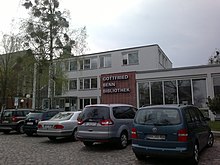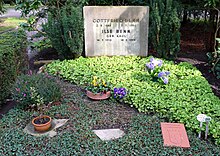Gottfried Benn
Gottfried Benn | |
|---|---|
 Gottfried Benn in 1934 | |
| Born | 2 May 1886 |
| Died | 7 July 1956 (aged 70) |
Gottfried Benn (2 May 1886 – 7 July 1956) was a German poet, essayist, and physician. He was nominated for the Nobel Prize in Literature five times.[1] He was awarded the Georg Büchner Prize in 1951.[2]
Biography and work
Family and beginnings
Gottfried Benn was born in a
In the summer of 1912, Benn started a romantic relationship with the Jewish poet Else Lasker-Schüler.
Gottfried Benn began his literary career as a poet when he published a booklet titled Morgue and other Poems in 1912, containing expressionist poems dealing with physical decay of flesh, with blood, cancer, and death — for example No III — Cycle:
Der einsame Backzahn einer Dirne, / die unbekannt verstorben war, / trug eine Goldplombe. / Die übrigen waren wie auf stille Verabredung / ausgegangen. / Den schlug der Leichendiener sich heraus, / versetzte ihn und ging für tanzen. / Denn, sagte er, / nur Erde solle zur Erde werden.
— Gottfried Benn[5]
The solitary molar of a hooker, / who had died a missing person, / held a gold filling. / As if by silent agreement, the rest / had fallen out. / The mortician knocked out the filling, / pawned it and went dancing. / Because, he said, / only earth should return to earth.

Poems like this "were received by critics and public with shock, dismay, even revulsion."[8] In 1913 a second volume of poems came out, titled Sons. New Poems.[9]
Benn's poetry projects an introverted
World War I and Weimar Republic
After the outbreak of
During the 1920s, he continued having a close relationship with Jewish poet Else Lasker-Schüler who addressed love poems to him. This bond to her is the subject of the film Mein Herz-niemandem (1997) by Helma Sanders-Brahms.
During the Third Reich
Hostile to the
The cultural policy of the new State didn't turn out the way he hoped, and in June
After the war
During World War II, Benn was posted to garrisons in eastern Germany where he wrote poems and essays. After the war, his work was banned by the Allies because of his initial support for Hitler. In 1951 he was awarded the Georg Büchner Prize. He died of cancer in West Berlin in 1956, and was buried in Waldfriedhof Dahlem, Berlin.

Reception
Benn had a great influence on German poetry immediately before World War I (as an expressionist), as well as after World War II (as the 'Static' poet).[14]
Books
- Morgue und andere Gedichte [Morgue and other Poems] (Berlin, 1912)
- Fleisch (1917)
- Die Gesammelten Schriften [The collected works] (Berlin, 1922)
- Schutt (1924)
- Betäubung (1925)
- Spaltung (1925)
- Nach dem Nihilismus (Berlin, 1932)
- Der Neue Staat und die Intellektuellen (1933)
- Kunst und Macht (1935)
- Ausgewählte Gedichte [Selected Poems] (May, 1936) Note: 1st edition contained two poems that were removed for the 2nd edition in November 1936: 'Mann und Frau gehen durch die Krebsbaracke' and 'D-Zug'. The vast majority of the 1st editions were collected and destroyed.
- Statische Gedichte [Static poems] (Zürich, 1948)
- Ptolemäer (Limes, 1949); ISBN 978-0-943045-20-7(pbk).
- Doppelleben (1950); autobiography translated as Double Life (edited, translated, and with a preface by ISBN 978-0-943045-19-1).
- Stimme hinter dem Vorhang; translated as ISBN 978-0-943045-10-8).
Collections
- Sämtliche Werke ("Stuttgarter Ausgabe"), ed. by ISBN 978-3-608-95313-8).
- Prose, Essays, Poems by Gottfried Benn, edited by ISBN 978-0-8264-0311-7(pbk.)
- Selected Poems (Clarendon German series) by Gottfried Benn (Oxford U.P., 1970, ISBN 978-0-19-832451-5)
- Gottfried Benn in Transition by Gottfried Benn, edited by ISBN 978-0-943045-21-4)
- Poems, 1937–1947 (Plutarch Press, 1991, ISBN 978-0-943045-06-1)
- Impromptus (ISBN 978-0-374-17537-5)
- Gottfried Benn – Friedrich Wilhelm Oelze: Briefwechsel 1932–1956, edited by Harald Steinhagen, Stephan Kraft and Holger Hof, 4 volumes, (Klett-Cotta/Wallstein, ISBN 978-3-8353-1826-7)
Notes
- ^ "Nomination Database". www.nobelprize.org. Retrieved 2017-04-19.
- ^ "Gottfried Benn". Deutsche Akademie für Sprache und Dichtung. Retrieved 12 November 2023.
- ISBN 978-0-7145-2500-6
- ^ cf p. x.
- ISBN 978-3-608-95313-8).
- ^ Translated and recited by Natias Neutert (with revisions added from the recent translation of David Paisey). Cf. Foolnotes, Booklet, Smith Gallery Performance, Soho New York 1980, p. 21.
- ^ Cf. Under the headline Latently existing words in the Frankfurter Rundschau, Anja Juhre-Wright talks with Natias Neutert about the difficulties of translating Benn. See external links
- ^ Reinhard Paul Becker: Introduction. In: Volkmar Sander (Ed.): Gottfried Benn. Prose, Essays, Poems. (Foreword by E.B. Ashton). The German L Vol. 73, Continuum, New York, p. XX*.
- ^ Gottfried Benn: Söhne. Neue Gedichte. Berlin (n.d. [1913].
- ISBN 978-0-06-015248-2
- ^ cf E.B. Ashton (Ed.): Gottfried Benn Primal Vision. New Directions Publishing Corporation, New York, p. xi–xii.
- ^ ISBN 978-0-520-07278-7, p. 367-8
- ^ Cf. Gottfried-Benn-Gesellschaft e.V. Freiburg im Breisgau, Germany: http://www.gottfriedbenn.de/lebenslauf.php
- ^ Derived from his most effective and well known work, from Gottfried Benn's Statische Gedichte. Arche Verlag, Zürich 1948/Limes Verlag Wiesbaden 1949 (with three more poems).
References
- German Dreams and German Dreamers: Gottfried Benn's German Universe by ISBN 978-1-55605-001-5(pbk.).
- Gottfried Benn: The Unreconstructed Expressionist by J. M. Ritchie (London: ISBN 978-0-85496-046-0.
- Beyond Nihilism: Gottfried Benn's Postmodernist Poetics by ISBN 978-0-8204-6275-2(pbk.).
- Gottfried Benn's Static Poetry: Aesthetic and Intellectual-Historical Interpretations by ISBN 978-0-8078-8112-5.
- ISBN 978-0-7145-2500-6
- ISBN 978-0-06-015248-2
- Gottfried Benn and his Critics: Major Interpretations 1912–1992 by Augustinus P. Dierick. [Columbia SC: Camden House Inc.], 1992.
- German Literature Under National Socialism by J. M. Ritchie (London: ISBN 978-0-389-20418-3.
- ISBN 978-0-218-51426-1.
- ISBN 978-0-13-089301-7).
- ISBN 978-0-297-00267-3.
- ISBN 978-1-56924-917-8
- Snow from Broken Eyes: Cocaine in the Lives and Works of Three Expressionist Poets, Richard Millington, (Peter Lang AG, 2012)
- “Das Ich ist ein Phantom.” The Crisis of Cartesianism and its Transcendence in Myth in Gottfried Benn’s Early Dramas.” by Augustinus P. Dierick. In: Analogon Rationis. Festschrift für Gerwin Mahrarens zum 65. Geburtstag. Ed. Marianne Henn and Christoph Lorey. Edmonton: University of Alberta Press, 1994, 357–389.
External links
- Works by Gottfried Benn at Project Gutenberg
- Works by or about Gottfried Benn at Internet Archive
- Translation of Astern/Asters
- Gottfried Benn in the German National Library catalogue
- Gottfried Benn Society, German language site
- Latently existing words
